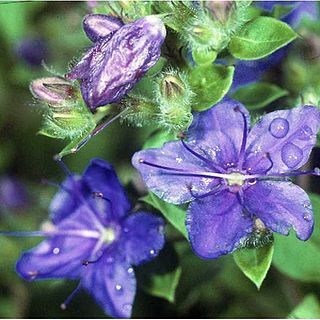Herbs, annual or perennial, or shrubby plants with capitate glandular hairs or glabrous, spiny (in Panama). Leaves alternate, entire. Inflorescences corymbose or flowers in axillary or terminal cymes. Florets rarely sparse or in cincinni; calyx parted nearly to the base, sometimes accrescent; corolla blue or rarely white, cam-panulate-rotate, deeply parted; stamens glabrous, the filaments dilated at the base, inserted in the tube of the corolla, the anthers sagittate, dorsifixed; ovules numerous (up to 400), the styles distinct, 2, rarely 3-5, the stigmas capitate-clavate. Capsule ovoid or globose, loculicidal, septicidal or irregularly dehiscent; seeds small, longi-tudinally rugose-striate, the embryo 0.4-0.5 mm long.
Capsule globose, ellipsoid or ovoid, thin, usually septicidally 2-valved; seeds numerous, minute.. Herbs or undershrubs, sometimes spiny, glabrous or glandular-pubescent. Leaves alternate, entire. Flowers in peduncled bracteate cymes, forming panicles or in false racemes or axillary clusters. Calyx-lobes 5, imbricate at the base, open above. Corolla often blue, rotate-campanulate, 5-lobed. Stamens 5, inserted at the sinuses of the corolla; filaments filiform, usually dilated at the base; anthers sagittate. Ovary 2(–3)-locular, with fleshy placentas adnate to the septa; ovules many per locule; styles 2, subulate, distinct from the base; stigmas simple or capitate
Sep narrow, distinct, unequal in width; cor broadly campanulate to subrotate, lobed to below the middle; filaments on the cor-tube, abruptly dilated at base; ovary bilocular; ovules very numerous on the broad axile placentas; styles 2; capsule globose, subtended by the persistent cal, mostly breaking irregularly or 2-valved; seeds minute; ours perennial herbs with alternate, entire lvs, usually axillary spines, and small or medium-sized blue fls in axillary or terminal cymes. 11, mainly tropical.
Stamens 5, inserted at the sinuses of the corolla; filaments filiform, usually dilated at the base; anthers sagittate.
Capsule globose, ellipsoid or ovoid, thin, usually septicidally bivalved; seeds numerous, minute.
Flowers in peduncled bracteate cymes, forming panicles or in false racemes or axillary clusters.
Ovary 2(3)-locular with fleshy placentas adnate to the septa; ovules many per locule.
Styles 2, subulate, distinct from the base; stigmas simple or capitate.
Herbs or subshrubs, sometimes spiny, glabrous or glandular-pubescent.
Flowers blue, in axillary clusters, or in terminal cymes
Calyx lobes 5, imbricate at the base, open above.
Corolla often blue, rotate-campanulate, 5-lobed.
Sepals 5, free to near the base, imbricate
Corolla 5-lobed to near the base, open
Leaves alternate, entire, narrow
Capsule septicidally 2-valved.
Ovary 2-(rarely 3-) celled
Leaves alternate, entire.
Styles 2, divergent
Anthers sagittate
Ovules numerous
Stamens 5
Herbs

